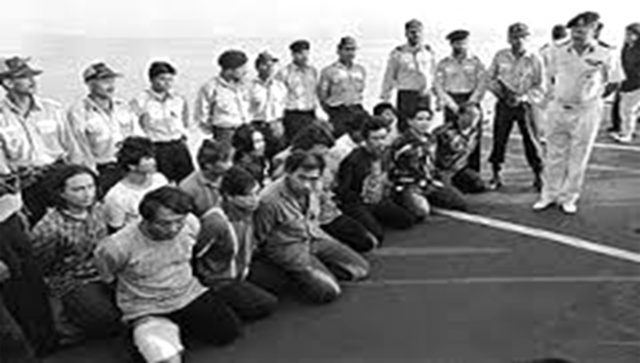(A true story about apprehension of pirates in Arabian Sea on 16 Nov 1999)
 By Addl DG AK Harbola (Retd)
By Addl DG AK Harbola (Retd)
We remember listening to the tales of the pirates, some glorified, others villainous but nearly all thrilling and entertaining. Stunned, sometimes scared, as a child I always wondered, how it’s done and how were they caught? One of the real-life incidents that has matched the drama and intensity of those stories as closely was the hijacking of the Japanese merchant ship, Alondra Rainbow, and its subsequent historical capture by the Indian Coast Guard (ICG) on 16 November 1999.
What unfolded was nothing short of a maritime thriller — a meticulously planned conspiracy, a mid-sea hijacking, the merciless disposal of the ship’s original crew into the sea, and an elaborate attempt to disguise the vessel’s identity. The chase that followed, spanning nearly 750 kilometres in the Arabian Sea, ended with the dramatic apprehension by the Coast Guard Ship, Tarabai.
Vice Admiral John D’Silva, then Director General of the ICG, later remarked, “We created history after a high-action drama at sea by apprehending MV Alondra Rainbow.”
The High Jacking
Alondra Rainbow was a Panamanian-registered merchant vessel owned by a Japanese company. She sailed from Kuala Tanjung, Indonesia, on 22 October 1999, for Miike, Japan, carrying 7,000 tons of aluminium ingots. The ship’s crew consisted of 15 Filipinos and two Japanese nationals.
When the vessel failed to report at its destination, the Piracy Reporting Centre (PRC) of the International Maritime Bureau (IMB) suspected foul play. The PRC quickly alerted the Indian Coast Guard Headquarters in New Delhi, the Directorate General of Shipping in Mumbai, and similar agencies worldwide.
The Chase
In the late evening of 13 November, the Indian captain of merchant vessel MV Al Shuhadaa reported sighting a ship resembling Alondra Rainbow 66 nautical miles off Kanyakumari, moving on a north-westerly course at the speed of eight knots.
The ICG immediately swung into action. After intense deliberations, with the daybreak on 14 November, a maritime surveillance aircraft was launched from the Coast Guard’s air base at Daman. The aircraft sighted the suspect vessel and relayed its position to CGS Tarabai, which sailed from Kochi with orders to intercept and “take necessary action” in line with standard guidelines to use the required force during action.
At 2200 hours, Tarabai intercepted the vessel at about 72 nautical miles from Kochi coast and repeatedly challenged it over radio but received no response. Instead, the ship increased speed and tried to flee. Warning shots were fired, the vessel, now responded to be Mega Rama, but continued her course.
Throughout the night, Tarabai shadowed the ship, and observed her altering course further westwards, an attempt to exit India’s Exclusive Economic Zone as quickly as possible. However, with dawn came the confirmation from Lloyd’s Register in London that no ship named Mega Rama existed. The chase intensified.
The Capture
After warnings went unheeded, Tarabai used higher calibre guns, targeting the ship’s engine room to flood and slow her down. By the afternoon, the Indian Naval ship Prahar also joined the chase and augmented the efforts of Tarabai. Consequent to further 16 hours of relentless pursuit, the fleeing vessel finally radioed distress message ‘Mayday’, reporting “engine room under fire and flooding”.
Sensing that the hijackers would attempt to feign distress to attract a passing merchant vessel, Tarabai, warned the merchant ship to stay clear. Four of the hijackers jumped into a life raft and were picked up by Tarabai’s boarding team.
Upon boarding, the Coast Guard officers warned the residual crew onboard to surrender, and confirmed the vessel’s true identity as Alondra Rainbow, finding items still marked with the original name. All the hijackers were detained on the spot.
By 0900 hours, Coast Guard ships Veera and Annie Besant arrived on scene followed by two more naval ships, and plugged the flooding. Tarabai, having accomplished her task, was detached from scene. Later, Veera later towed the crippled Alondra Rainbow to Mumbai. According to then Director of Operations at Coast Guard headquarters, DIG Paleri, congratulating messages started pouring in to the Coast Guard headquarters at Delhi from across the world. The then Defence Minister, George Fernandes, personally visited Tarabai in Mumbai to commend her crew.
Being the first case of its kind, investigators initially struggled to frame appropriate charges against the pirates. One of the leading national newspapers quipped that the Coast Guard was “at sea” about how to “book” the offenders. Eventually, after prolonged legal proceedings, 17 hijackers were sentenced by the session’s court at Mumbai to 11 years in prison each.
Takeaways
Beyond the drama, the incident carried lasting lessons. It showcased India’s growing maritime capabilities and established the Indian Coast Guard as a credible force for ensuring rule of law and the safety of seafarers. The operation strengthened Indo-Japanese maritime cooperation, leading to regular visits and joint exercises between the two nations’ coast guards.
The Regional Cooperation Agreement on Combating Piracy and Armed Robbery against Ships in Asia (ReCAAP) between 16 countries in Asia was concluded in 2004. Requirement of improved ‘maritime law enforcement’ was realised, resulting in more member nations ratifying Suppression of Unlawful Acts Against the safety of Maritime Navigation (SUA) convention. India also enacted ‘The Suppression of Unlawful Acts Against Safety of Maritime Navigation and Fixed Platforms on Continental Shelf Act’ in 2002. In India, among the stakeholders, momentum gained for a ‘The Maritime Anti-Piracy Act’, which was finally enacted in 2022.
The capture of Alondra Rainbow is maritime history and a sort of record. Terrain wise, maritime element of India’s national interests is vast, stretching from the Arabian Sea to the Indo-Pacific and beyond. Law enforcement from national waters up to the high seas remains complex, but the Indian Coast Guard is well poised to build the confidence in seafarers towards their safety and to deter the unruly elements. What it needs is consistent support from policymakers at the highest levels to continue strengthening its readiness, reach and reputation.
(The writer, Addl DG AK Harbola (Retd), ICG, was commanding CGS Tarabai during the operation. He was awarded the Tatrakshak Medal (Gallantry) by the President of India for his gallant act. Currently, he is associated with Rashtriya Raksha University, Gandhinagar (Gujarat).)








